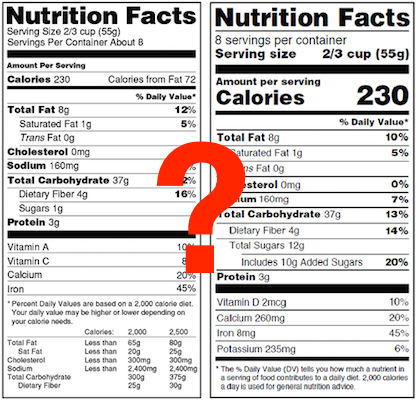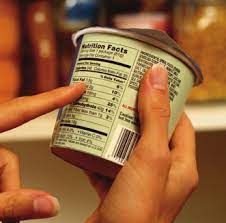Nutrition Label Requirements
When you have a food business the question of nutrition facts panels will eventually arise. Maybe a customer or a store that is considering carrying your product is requesting them. Maybe you’re selling on Amazon. Or maybe you’re curious about the nutrition in your product for yourself or marketing purposes. However, it can be confusing to understand all the nutrition facts label requirements.
Clearly there are times when you need a nutrition facts panel to sell your product and times when you just want one. We're here to help you navigate all the nutrition facts guidelines. In this post we’ll go over everything you need to know about the FDA’s nutrition facts requirements.
If you decide that you are going ahead with putting nutrition labels on your food products, we highly recommend using nutrition analysis software and nutrition label software like ReciPal to figure out your nutrition based on your recipe and ingredients and then format your labels based on those calculations. It will save you hours and hours compared to doing it yourself, remove the worries of whether you formatted it correctly, and you’ll join tens of thousands of food businesses using it already with the support you need. You’ll have lots of label format options and be able to download a digital file like a PDF or PNG to print your labels.
What Are Nutrition Facts Panels For?
The nutrition facts panel tells consumers what nutrients are in their food. It shows them nutritional information on calories, fat, sugar, protein, and vitamins are in a food so that they can decide what to eat.
When Are You Required to Include Nutrition Facts on Products?
Naturally, you should ask yourself if you NEED nutrition labels on your packaging. So when do you? Here are the three criteria:
- Foods that you make any nutrient claims for (e.g. "High in fiber", "Low fat", etc.). This is the number one rule that requires nutrition facts labeling. Even if otherwise you meet any exemptions, you have to include nutrition facts if you make any nutrient claims on your package label or website.
- Retailers that have more than $50,000 of food sales AND more than $500,000 of total sales. This rule covers both your own business and any that sell your product, so if you want to be in almost any grocery store, you'll need nutrition fact labels. The thing to keep in mind here is that BOTH conditions have to be met: if you sell $53,000 of food but your total sales are $498,000, this one doesn’t apply to you.
- Businesses with more than 100 full-time equivalent employees (FTEs) OR sales of more than 100,000 units of a product. Notice that this rule applies if you meet either condition: If you have 101 FTEs it applies no matter how many units you sell. And if you sell 101,000 units, it applies even if you’re doing it all yourself.
Most food companies start providing nutrition facts on their labels well before they hit any of these thresholds because it's good practice, provides a layer of transparency for your customers, and just seems like the right thing to do.
In What Cases Are You Not Required to Include Nutritional Facts?
On the flip side, the following is a list of foods and situations which are exempt from having nutrition facts:
- Raw fruits, vegetables, and fish.
- Foods that contain insignificant amounts of all required nutrients (insignificant means it can be listed as zero after rounding rules - foods that fall under this exemption include tea, coffee, food coloring, etc.).
- Small packages where the total surface area of the package available for labeling is less than 12 square inches.
- Retailers that have less than $50,000 of food sales (and any amount of total sales) OR less than $500,000 of total sales (and any amount of food sales).
- Low volume food products: to claim this exemption you must employ fewer than 100 FTEs AND sell fewer than 100,000 units of the product per year. This exemption must be filed with the FDA on paper unless you employ fewer than 10 FTEs and have annual sales of fewer than 10,000 units. Once you break the 100,000 unit or 100 FTE threshold you then have 18 months to start labeling your foods with nutrition facts.
Remember: you lose any exemption you qualify for if you make a nutrient claim on your product label!
How Have the Laws Around Nutrition Facts Labels Changed?
The nutrition information panel was born in 1990 when the Nutrition Labeling and Education Act (NLEA) was passed. The idea under the NLEA was to create a format for nutrition facts information that would be easy to understand and flexible enough to keep up with changing knowledge about nutrition. But nothing changed until a revamp in 2016. The first updates to the nutrition facts panel in a quarter of a century went into effect for all manufacturers who are regulated by the FDA on January 1, 2021.
The USDA hasn’t formally adopted the new format but does accept it, so anyone under USDA jurisdiction has options.
The updated label:
- Changed the layout to emphasize calories more
- Added a new dual column format for packages with 2 to 3 servings
- Changed the required vitamins and minerals to reflect current nutrient deficiencies
- Updated the recommended daily intake for several nutrients (which changes the %DV for them)
- Changed the definition of fiber
- Included a new line for added sugars, and
- Revamped the reference amounts for serving sizes for some categories (e.g., ice cream and yogurt).
What Are the Nutrition Facts Label Requirements?
Nutrition facts requirements:
- The serving size and number of servings in the container
- The calories per serving (and per container if you have 2-3 servings in your package)
- Total fat
- Saturated fat
- Trans fat
- Cholesterol
- Sodium
- Total carbohydrates
- Fiber
- Sugar
- Added sugar
- Protein
- Vitamin D
- Calcium
- Iron
- Potassium
- The actual value for the amount of the nutrient, and
- The percentage of the daily recommended value of that nutrient the serving provides (except for trans fat, total sugars, and protein, but you’re allowed to show a %DV for protein if you want to).
You’re also allowed to include information for other nutrients like sugar alcohols and unsaturated fats or for vitamins and minerals you might want to highlight in your product, like Vitamin C and A, Magnesium, and Zinc, and more.
A word of warning: there are times when optional nutrients are required, usually if you’re making a claim about them.
FDA Rounding Rules
Another piece of the puzzle is that everything in the label has to be rounded, and there are different rounding rules for each element. It gets so detailed that we have an entire post on FDA nutrition label rounding rules! Rules like this are why we designed ReciPal. Our nutrition fact software makes it easy for food entrepreneurs to follow all the nutrition label requirements.
Designing a Nutrition Information Label
By now you can see that there are rules for everything, so it won’t be surprising that there are more for layout, formatting, fonts, etc. With all the complexity, you might be asking "so how do I get nutrition facts for my product?" Of course you can design one yourself (if you do, definitely make sure you’re working with someone who really knows the food labeling rules!), but why reinvent the wheel? You can use a tool like ReciPal and leverage our nutrition label templates where all the formatting, calculations, and rounding are taken care of for you so it’s easy to comply with the nutrition facts label requirements. And if you need help beyond that, you can work with a ReciPal labeling expert. Beyond just the requirements and formatting, we have a great getting started article for you to learn about nutrition analysis and the different options available to you as a food business.






